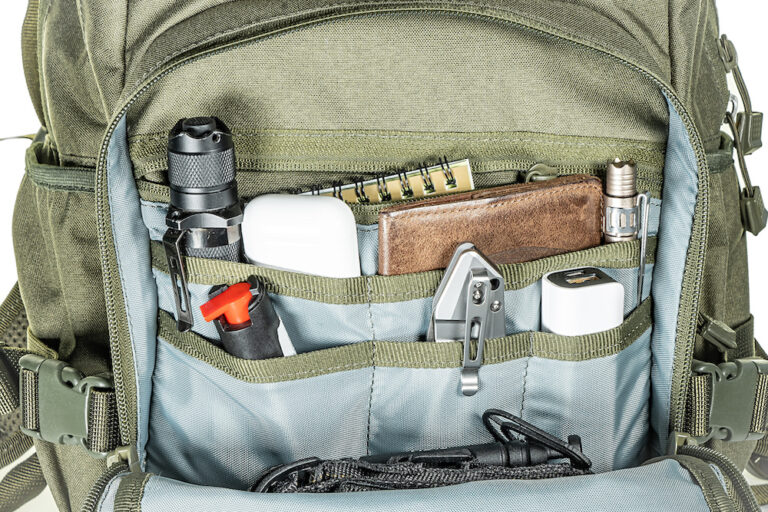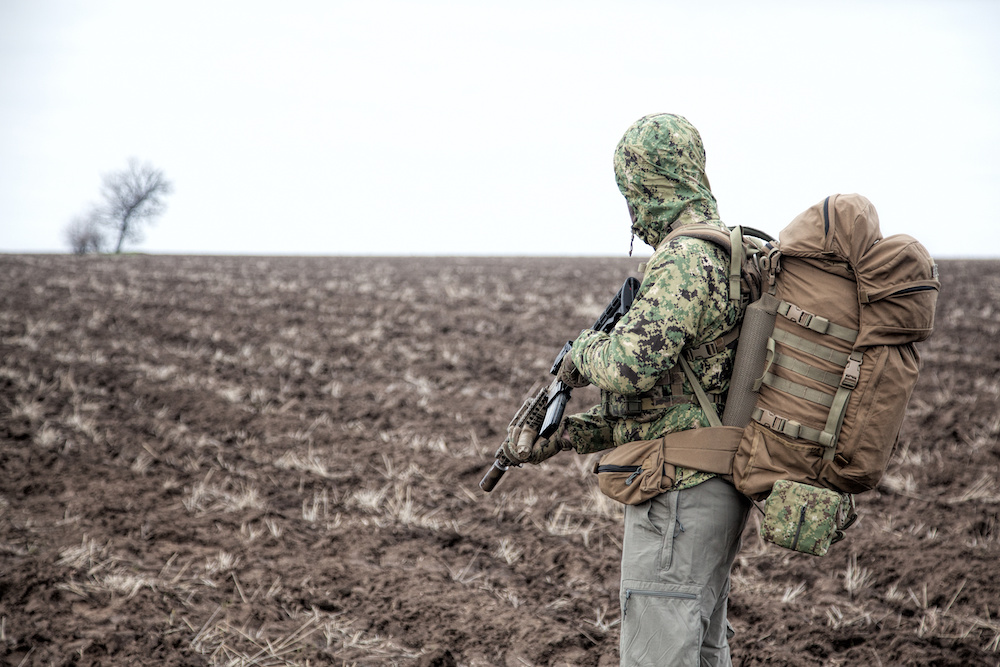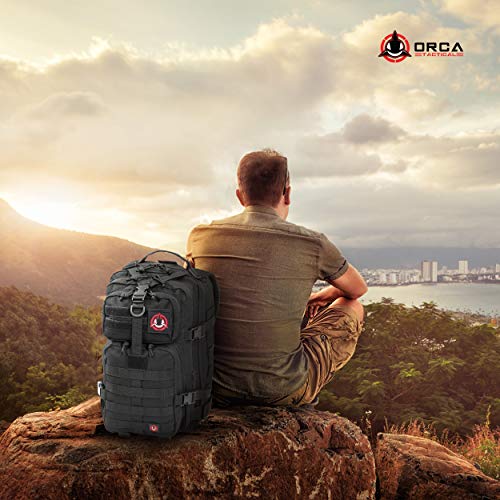Signup for our monthly newsletter and get your FREE "Tactical Gear" Guide
What To Pack in a Tactical Backpack?
- Home
- Tactical Backpacks Advice
- What To Pack in a Tactical Backpack

This site contains affiliate links to products. We may receive a commission for purchases made through these links.
Not sure what to pack in a tactical backpack?
Knowing what the essentials are helps you be prepared for whatever situation you might encounter in the wild.
Also, depending on the event, you need to consider getting more than just a few items.
It’s important to determine what type of tactical backpack will best serve your needs, too.
Table of Contents
What Are Tactical Backpacks For?
Tactical backpacks are incredibly useful bags specifically designed for impressive storage and organization.
They were initially designed for military personnel but have since become a fantastic option for commuters, adventurers, and more.
Ensuring you have the appropriate carry-all will guarantee optimal storage, ease of use, and comfortable carrying.
What Backpacks Do Navy SEALs Use?
Among the first things Navy SEALs consider is the type of tactical backpack they will need for their excursion.
The three most popular options are EDC bags, 24-hour backpacks, and three-day bags.
EDC Bags
Also known as everyday-carry bags, these backpacks are designed to hold a small number of items.
Typically, users will carry their bare essentials that will need to be restocked day-to-day.
You might also find that these are referred to as 12-hour backpacks, depending on where you are shopping.
On average, EDC bags can range between five and 35 liters, with plenty of internal storage solutions.
It will be much easier for you to keep your belongings organized in an assortment of easy-access compartments.
You’ll also find that they prove useful for short hikes, training missions, and everyday needs like commuting.
24 - Hour Backpacks
As the name suggests, these bags are designed for overnight trips where you will need more than an EDC bag offers.
Typically, these bags are between 30 and 40 liters, which is slightly larger than their smaller counterpart.
With these, you’ll be able to carry an extra pair of clothes on top of your everyday essentials.
24-hour backpacks will also have a few extra benefits that add to its stability and security.
For example, the shoulder straps will most likely feature sternum/chest straps and hip/waist straps for more comfortable carrying.
Due to their larger size, they will also have added support and reinforced seams.
Three - Day Backpacks
As the most viable option out of the three, three-day backpacks are ideal for long-distance trips.
If you’re heading out into the desert for a few days at a time, this is the type of bag you’ll need.
You’ll be able to carry plenty of essential resources as well as extra pairs of clothing.
Undoubtedly, you will find three-day backpacks to be ideal for portaging and wilderness excursions.
However, load management is crucial with these styles, as they are easily overpacked.

Benefits of Tactical Backpacks
Are tactical backpacks even necessary?
To decide if this is the right kind of bag for your trip, here are the advantages it offers over other bags:
1. Load Management
Another thing to consider when choosing your backpack is how comfortable it will be to carry.
You won’t want to invest in a tactical bag with poor load management, leading to fatigue and injury.
There are a few key components to consider based on the size and general weight of the backpack.
Shoulder Straps
Shoulder straps are imperative to load management, as it’s where the straps will hold most of the bag’s weight.
Most traditional backpacks have straight shoulder straps, which look great but don’t offer much ergonomics.
You’ll find that their large width can offer plenty of padding but can cause discomfort after a couple of hours.
The second option is curved shoulder straps, which most users often prefer.
They have the same type of padding as straight options, but they are more anatomically-correct.
The curvature of the straps will hug your body comfortably for a more ergonomic fit.
As the last option, one-piece or Y-shaped shoulder straps can be ideal.
They are designed with durability and ruggedness in mind, allowing you to carry heavier loads effortlessly.
You’ll find these styles are bound to stand up the best against wear and tear.
Sternum Straps
Also referred to as chest straps, sternum straps are an essential component of tactical bags.
The sternum strap helps evenly distribute weight across your chest, shoulders, and back when appropriately used.
You’ll also find that it helps keep your bag in place when you’re navigating tough obstacles.
Hip/Waist Belts
For even more professional weight distribution, hip or waist belts are ideal.
When your backpack is over 20 pounds, you’ll likely need more weight distribution for practical carrying.
If you’re venturing out onto a long-distance trek, a hip/waist belt will hug the top of your hips for added ergonomics.
You’ll also find that this feature is ideal for reducing the energy you spend when climbing rough terrain.
2. Organization
The primary reason why people transition to tactical backpacks is to have added organization.
Compared to standard backpacks, tactical packs have a ton of pockets and internal storage.
You’ll be able to carry extra clothes, MREs, first-aid gear, and even weapons while keeping everything separate.
The most common compartments you’re bound to find in a military bag include:
Main Compartment
The main compartment is where the bulk of your items will be stored.
You’ll be able to access this area with a zipper, and it has an enormous volume out of all the other compartments.
You might find organizational dividers, laptop sleeves, and small pockets for valuables inside the main compartment.
Secondary Compartments
Most often, secondary compartments are located on the exterior of the backpack at the front.
They typically zip down for easy access and offer plenty of storage for smaller pieces of gear.
For example, you can store extra flashlights, batteries, keys, and other items that need better organization.
Within your secondary compartment, you might find extra storage solutions like pen holders, zippered mesh pouches, and more.
CCW Compartment
In tactical situations, you need to make sure you have easy access to your weapon at all times.
CCW compartments are specialty components that allow you to holster and draw your gun while carrying your backpack.
These pockets are designed explicitly for firearms so that you can carry them discreetly.
More often than not, you’ll also find storage for extra ammo and other accessories.
The sole purpose of a CCW compartment is to allow you to quick-draw if needed.
What Are the Loops for on Military Backpacks?
Another iconic form of storage on tactical backpacks is MOLLE webbing.
It’s one of the most-used storage solutions in the military, as it offers impressive organizational utility.
With this storage solution, you can add extra pouches to the outside of your pack for an assortment of items.
You’ll have easier access to extra ammo, flashlights, radios, phones, and first-aid gear.
Instead of having to open the main compartment, you can quickly access each pouch.
Another substantial benefit of MOLLE webbing is that it allows you to customize your backpack.
With this, you’ll have full control over where you place each extra pouch, customizing the layout of your gear.
What To Pack in a Survival Backpack
There’s plenty to consider when buying a tactical backpack, from its materials to its storage options.
When you’ve picked the perfect design for your needs, the next step is to know what to bring with you.
Considering it’s too easy to overpack these larger-sized bags, keeping your packing list to include only the essentials is important.
1. Safety and Shelter
The first group of assault pack contents to consider when packing are things you’ll need for safety and shelter.
For shelter, you’ll want to think about what you’ll need to be safe and secure while outdoors, including:
- Tent
- Stakes
- Tarp
- Paracord
- Sleeping bag
- Space blanket
For safety, you’ll have to consider any items you’ll need to defend yourself against the elements and predators.
When deciding this, it’s essential to take your surroundings and wildlife into consideration so that you’re prepared for anything.
Some of the most common items for safety include:
- Weapon
- Extra ammo and magazines
- Hunting knife
- Flashlights
- Extra flashlight batteries
- Portable power bank (solar-powered)
2. First-Aid Kit
The second most important assault pack contents are first-aid kits.
While you can always opt to purchase one from a big box store, it might not always have everything you need.
Like choosing items for safety, consider your environment when selecting a first-aid kit.
Ensure you have the appropriate tools and medications to counteract nature.
For example, you won’t need bug sting cream if you’re venturing out in the middle of winter.
The essential items to keep in your first-aid kit include:
- Duct tape
- Butterfly sutures
- Gauze
- Adhesive wound dressings
- Antibiotic creams/ointments
- Antiseptics and disinfectants
- Broad-spectrum antibiotics
- Burn creams
- Chemical ice bags
- Lidocaine
- Aspirin or Tylenol
- Oral and topical antihistamines
- EpiPen (if needed)
- Personal OTC medications
- Personal prescription medications
- Vaseline
- Scissors
- Tweezers
- Disposable thermometer
- Disposable gloves
- Tourniquets
- Splints
- First-aid instructions
3. Tools
When figuring out what to put in a survival backpack, you’ll find that you actually need an assortment of tools.
Keep in mind that they can also take up a substantial amount of weight in your pack.
It’s best to combine multiple tools in one, such as having a multi-tool with several components.
Otherwise, you’ll be adding unnecessary weight to your pack.
Apart from a multi-tool, we also highly recommend keeping a pair of pliers, a folding knife, and a smaller pocket knife on hand.
Also, in the realm of tools, consider bear spray, bear horns, and emergency whistles.
A few other key items to have on your list are:
- Topographic map
- Solar-powered GPS device
- Compass
- Pots and pans
- Paracord
- Dry bags
4. Fire-Starter Tools
Fire-starter tools deserve their section merely because of how important they are to survival.
Without fire, you’ll be unable to stay warm, cook your food, and in most cases, purify water for drinking.
Here’s what to pack in a survival backpack to ensure you have everything you need to start a fire:
- Waterproof matches
- Flint and steel
- Windproof lighter
- Lighter fluid (if necessary)
5. Food and Water
Food and water are necessities in any survival situation, which is why they are among the most important items you’ll have to pack.
When figuring out what to put in a survival backpack, make sure you have at least one week’s worth of food, including snacks.
You’ll also need access to a source of fresh and clean drinking water.
As water can be quite heavy, some groups recommend bringing a method of water purification instead.
A few recommendations for food and water preparedness include:
- Water purification tablets
- Portable water purifier
- MREs
- High-protein snacks
6. Hygiene
When you’re exposed to the elements, it’s easier to get dirty than you’d think.
Unfortunately, dirt can lead to significant infections that can also result in life-threatening conditions.
As you can imagine, your hygiene is of the utmost importance when you’re away from showers.
For hygiene, you’ll want to consider bringing the following:
- Soap
- Toothpaste
- Toothbrush
- Razor
- Dental floss
- Deodorant
- Shampoo
- Conditioner
- Microfiber cloths
- Hand sanitizer
- Nail clippers
7. Clothing
Regardless if you’re planning a long-distance trip or a short midday hike, having spare clothing is essential.
After all, you never know when you’ll get caught in torrential weather and need to change quickly.
Without dry and clean clothing, you’ll be exposed to the elements and susceptible to hypothermia, overheating, and more.
There are several recommendations for clothing when deciding what to pack in a tactical backpack, including:
- Rain jacket
- Spare socks
- Spare underwear
- Breathable t-shirts
- Sweater
- Spare pants
- Spare shorts
Obviously, it’s important to consider the time of year, as it can make a significant difference as to what you bring with you.
It’s unlikely you’ll need a breathable T-shirt if you’re hiking in the winter.
On the other hand, you will likely need an extra sweater if the area you’re in gets colder at night.
Basically, you’ll want to ensure you have the supplies to stay warm, dry, and comfortable while outdoors.
How Do You Pack a Military Backpack?
The last thing to consider is how to pack a tactical backpack.
Contrary to popular belief, you don’t try to shove as much as you can in every pocket.
With an efficient packing method, you can evenly distribute weight, allowing you to carry several items easily.
Bottom - Middle - Top Method
Using the bottom-middle-top technique, you can effortlessly organize the main compartment of your backpack.
Bottom
Keep your most non-urgent items at the bottom of your backpack.
Otherwise, you’ll be rifling through all of your belongings to get to essential things.
Typically, you should pack clothes, bedding, and hygiene products towards the bottom.
Middle
In the center of your bag, you’ll want to include medium-weight essentials.
These items will include your water, food, shelter, and fire-starting products.
Top
All of your most-used items should be easily accessible at the top of your backpack.
These items can include flashlights, defense tools, and communication devices.
Note that this is the most crucial part of learning how to pack a tactical backpack, as these items cannot be obstructed.
Pockets
Fortunately, the majority of tactical packs have plenty of exterior pockets for you to use.
In these pockets, you can keep more of your essentials, such as navigation gear and weapons.
Organize your belongings by importance depending on how easy the pockets are to access.
Packing a Tactical Backpack
Even if you have the best tactical bag money can buy, it won’t mean much if you don’t know how to pack it.
Thankfully, learning what to pack in a tactical backpack is relatively straightforward once you have a good packing list.
Using the tips we explored earlier, you can ensure all of your necessities are included and easy to access.


